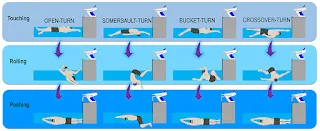POST #17 Individual Medley: Biomechanical features of backstroke to breaststroke transition techniques
NEW STUDY on Frontiers Sports and Active Living
LINK: CLICK HERE
This study aimed to identify the biomechanical features of backstroke to breaststroke transition techniques (open, somersault, bucket, and crossover) in age-group swimmers. Eighteen preadolescent swimmers (12.2 ± 0.4 years old and 3–4 Tanner stages) underwent 4 weeks of systematic contextual interference training, comprising 16 sessions (40 min·session−1). Soon after, experimental testing was conducted where swimmers randomly performed 12 × 15 m maximal turns (composed of 7.5 m turn-in and 7.5 m turn-out of the wall segments), three in each transition technique. Kinematical, kinetic, and hydrodynamic variables were assessed with a dual-media motion capture system (12 land and 11 underwater cameras), triaxial underwater force plates, and inverse dynamics. Variables were grouped in turn-in (approach and rotation) and turn-out (wall contact, gliding, and pull-out) phases, with factor analysis used to select the variables entering on multiple regressions. For the turn-in phase, 86, 77, 89, and 87% of the variance for open, somersault, bucket, and crossover turning techniques, respectively, was accounted by the 7.5 and 2.5 m times, mean stroke length, and rotation time. For the turn-out phase, first gliding distance and time, second gliding depth, turn-out time, and dominating peak_Z push-off force accounted for 93% in open turn, while wall contact time, first gliding distance, breakout distance and time, turn-out time, dominating peak_Y push-off force, and second gliding drag coefficient accounted for 92% in a somersault turn. The foot plant index, push-off velocity, second gliding distance, and turn-out time accounted for 92% in bucket turn while breakout and turn-out time, non-dominating peak_Y and peak_Z push-off force, first and second gliding drag force and second gliding drag coefficient accounted for 90% in crossover turn, respectively. The findings in this study were novel and provided relevant biomechanical contribution, focusing on the key kinematic–temporal determinant during turn-in, rotation, and push-off efficacy, and the kinetic and hydrodynamic during turn-out, which would lead to improved backstroke to breaststroke transition techniques in 11–13 years-old age-group swimmers.
Keywords: Exercise, aquatic locomotion, swimming, biomechanics, motion capture, force plate, hydrodynamics, performance
Citation: Chainok P, de Jesus K, Mourão L, Fonseca PFP, Zacca R, Fernandes RJ and Vilas-Boas JP (2022) Biomechanical Features of Backstroke to Breaststroke Transition Techniques in Age-Group Swimmers. Front. Sports Act. Living 4:802967. doi: 10.3389/fspor.2022.802967
Copyright © 2022 Chainok, de Jesus, Mourão, Fonseca, Zacca, Fernandes and Vilas-Boas. This is an open-access article distributed under the terms of the Creative Commons Attribution License (CC BY). The use, distribution or reproduction in other forums is permitted, provided the original author(s) and the copyright owner(s) are credited and that the original publication in this journal is cited, in accordance with accepted academic practice. No use, distribution or reproduction is permitted which does not comply with these terms.



Comentários
Postar um comentário